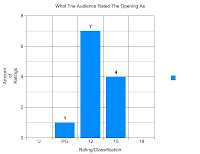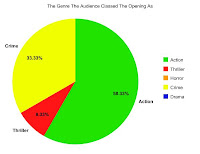To make our project as realistic as possible we went all out right from the start trying to make everything not just great but perfect; props, location, character's and just trying to make the feel of the movie authentic. In our fight scene we used a hand held camera effect to make the audience feel like they are part of our movie. We also spent alot of time testing out different gun shots, punch sounds and music. To make our film more like that of its genre we took a sample of some music from the bourne films. We also used the official passes of that at the office and we also used an air rifle with a real sniper scope to add to its authenticity. The handgun we used was also made of metal and looked very authentic. Finally we spent alot of time and money deciding on Luis' costume and the image of the guards. In a attempt to symbolise ranking between the guards we made the costumes of each person different. Danny with shirt and tie making him the smart front desk guard, Chris have the plain Shirt showing he isn't afraid to get his hands dirty, and Dan in the blazer to show he is the head guard.
The images with a red boarder are screen shots from our own production to show the similarity between that of the hollywood style movies and our own 'gritty' british film.
2. How Does Your Media Project Represent Certain Social Groups?
In our film we have an all male cast. The introduction of a female may happen later but the stars are all males with the ability to take on situation that occur in our genre. This is stereotypical of the action genre, allowing us to add to the authenticity. The males in our film our represented as stereotypically as possible. The guards not taking any prisoners with a 'kill on contact' state of mind, shown by the fact they draw their guns at the first sign of any trouble and are not afraid to shoot at intruders. Luis has the stereotypical build and style of someone who would break into a goverment building, also dressed in the way that allows more authenticity. We dressed alex in black with the headset to make him look like the geek in our project, also the clip of the security footage of Dan finding a knocked out Danny adds to the audiences point of seeing the nerd has hacked into the goverment cameras, adding authenticity again. Last, Oli's role as sniper is a very stereotypical, hidden identity, character. All the males in the project our represented as stereotypically to the characters as possible.3. What Kind Of Media Institution Would Distribute Your Media Project? Why?
Our film is based as a low budget british film, so it would be aimed at Channel 4, E4, ITV and the BBC. Sky Movies would not be suitable as they show mostly big budget hollywood movies. Therefore our film is more suited to the smaller less film specified channels. Other films produced by these companies are the likes of academy award winning Slumdog millionaire, Looking for Eric (produced by E4) and the comedy 'The Men who stare at goats' starring George Clooney produced by the BBC
4. Who Is The Target Audience For Your Media Project?
Our project was aimed at teenagers with a rating of 12. This is because most films in our genre have the same rating due to the Blood and moderate violence used. Thinking about these properties of a film we had to incorporate fighting into our storyboard, although in moderation to keep the project a 12 and not an 15.
The BBFC (British Board Of Film Classification, in association with the Human Rights Act, the Licensing Act and the Video Recordings Act) classifies films under certain guidelines, the general ones are listed below:

- The film is not allowed to conflict the law or have been created by commiting a criminal offence
- The film is not allowed to cause harm to the viewer, either to their behaviour or morally, such as encouraging anti-social attitudes or distorting the viewers sense of right and wrong.
- Whether the content is acceptable for the particular age group in terms of things like bad language.
5.How Did You Attract/Adress Your Audience?
After making our video we showed a variety of people asking them all for their opinions and thoughts. We also spread the word to lots of people in the build up to making the video and advertised it between our friends which spread out to a big group of people our age interested in watching the video. We could also put a short clip on Youtube advertising the project or post it on one of our Facebook (a social networking site) pages.



6.What Have You Learnt About Technologies From The Process Of Constructing This Project?
Whilst producing our video i used many different types of filming and editing equipment.The camera is one of the greatest pieces of equipment made with the ability to shoot almost any angle or shot. The tripod is a piece of equipment that was really helpful, allowing us to keep a steady shot and be able to leave the camera in a certain angle whilst filming another angle with another camera. The editing software we used was also very advanced. I learnt how to trim clips down, fade them into each other, add different effects to the clip, add sounds and music, add titles and credits and also render a finished project. The last piece of technology i learnt about was how to use blogger to keep a record of what i have been doing experimenting with the different fonts and colours.

7. Looking Back At The Preliminary Task, How Do You Feel You Have Progressed In The Transition From Creating That To Creating The Final Project?
In the preliminary task we used basic skills, shots and angles. In our actual project we used a range of different skills such as the ability to maintain continuity between our shots, being able to use any one of the very wide range of shots and angles and being confident in knowing the action genre inside out. I feel i have progressed in terms of directing a film now being able to control the set, also in post-production i feel i understand alot more about what occurs in the editing process. Finally i feel my general knowledge of the film industry has increased by taking a first hand attempt at making an opening sequence.









 This scene opens with luis (the protagonist) breaking into the goverment building, taking out the first guard played by danny goodman. He comes from behind danny knocking him unconscious by snapping his neck. On the front desk there was also a CCTV monitor which allowed us to show luis running across the car park to break in. We chose this opening to add suspense and tension in the opening seconds.
This scene opens with luis (the protagonist) breaking into the goverment building, taking out the first guard played by danny goodman. He comes from behind danny knocking him unconscious by snapping his neck. On the front desk there was also a CCTV monitor which allowed us to show luis running across the car park to break in. We chose this opening to add suspense and tension in the opening seconds.
























